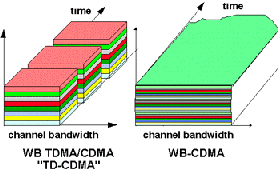|
|
|
|
|
|
WCDMA (UMTS)
TDCDMA
CDMA2000
WCDMA (DoCoMo)
TD-SCDMA
|
|
Mobiles
Bluetooth
HomeRF/SWAP
WAP
GPRS, HSCSD
EDGE
CAMEL, IN
|
|
WCDMA (UMTS)
 Wideband Code-Division Multiple-Access (W-CDMA) is one of the main technologies for the implementation of third-generation (3G) cellular systems. It is base on radio access technique proposed by ETSI Alpha group and the specifications was finalised 1999. Wideband Code-Division Multiple-Access (W-CDMA) is one of the main technologies for the implementation of third-generation (3G) cellular systems. It is base on radio access technique proposed by ETSI Alpha group and the specifications was finalised 1999.
The implementation of W-CDMA will be a technical challenge because of it's complexity and versatility. The complexity of W-CDMA systems can be viewed from different angles: the complexity of each single algorithm, the complexity of the overall system and the computational complexity of a receiver. W-CDMA link-level simulations are over 10 times more compute-intensive than current second-generation simulations. In W-CDMA interface different users can simultaneously transmit at different data rates and data rates can even vary in time. UMTS networks need to support all current second generation services and numerous new applications and services.
FDD Technical summary
Frequency band:1920 MHz -1980 MHz and 2110 MHz - 2170 MHz (Frequency Division Duplex) UL and DL [more]
Minimum frequency band required: ~ 2x5MHz
Frequency re-use: 1
Carrier Spacing: 4.4MHz - 5.2 MHz
Maximum number of (voice) channels on 2x5MHz: ~196 (spreading factor 256 UL, AMR 7.95kbps) / ~98 (spreading factor 128 UL, AMR 12.2kbps)
Voice coding: AMR codecs (4.75 kHz - 12.2 kHz, GSM EFR=12.2 kHz) and SID (1.8 kHz)
Channel coding: Convolutional coding, Turbo code for high rate data
Duplexer needed (190MHz separation), Asymmetric connection supported
Tx/Rx isolation: MS: 55dB, BS: 80dB
Receiver: Rake
Receiver sensitivity: Node B: -121dBm, Mobile -117dBm at BER of 10-3
Data type: Packet and circuit switch
Modulation: QPSK
Pulse shaping: Root raised cosine, roll-off = 0.22
Chip rate: 3.84 Mcps
Channel raster: 200 kHz
Maximum user data rate (Physical channel): ~ 2.3Mbps (spreading factor 4, parallel codes (3 DL / 6 UL), 1/2 rate coding), but interference limited.
Maximum user data rate (Offered): 384 kbps (year 2002), higher rates ( ~ 2 Mbps) in the near future. HSPDA will offer data speeds up to 8-10 Mbps (and 20 Mbps for MIMO systems)
Channel bit rate: 5.76Mbps
Frame length: 10ms (38400 chips)
Number of slots / frame: 15
Number of chips / slot: 2560 chips
Handovers: Soft, Softer, (interfrequency: Hard)
Power control period: Time slot = 1500 Hz rate
Power control step size: 0.5, 1, 1.5 and 2 dB (Variable)
Power control range: UL 80dB, DL 30dB
Mobile peak power: Power class 1: +33 dBm (+1dB/-3dB) = 2W; class 2 +27 dBm, class 3 +24 dBm, class 4 +21 dBm
Number of unique base station identification codes: 512 / frequency
Physical layer spreading factors: 4 ... 256 UL, 4 ... 512 DL
|
|